Are you getting it in the neck?
Now I’m not talking about getting it in the neck from the other half! I’m talking about neck pain and headaches.
Cervicogenic headaches, or headaches arising from the neck, are estimated to affect 22-25% of the adult population, with females being four times more affected than males. The symptoms can be similar to tension-type headaches and migraines, so the diagnosis can be overlooked.
This type of headache is caused by musculoskeletal dysfunction in the neck and can cause that dull pain at the base of the skull or above the eyes. Patients can also report dizziness or light-headedness.
Some people with chronic headaches depend on medication to get by, but a recent study in the Journal of Manual and Manipulative Therapy 2013: 21(2), reminds us how effective conservative care is. I won’t bore you with the details but the conclusion was that manipulation and mobilisation by a therapist, combined with cervico-scapular strengthening exercises was proven effective for decreasing pain. Think about that before you reach for the medication and reach for the phone instead.


